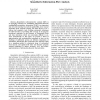Free Online Productivity Tools
i2Speak
i2Symbol
i2OCR
iTex2Img
iWeb2Print
iWeb2Shot
i2Type
iPdf2Split
iPdf2Merge
i2Bopomofo
i2Arabic
i2Style
i2Image
i2PDF
iLatex2Rtf
Sci2ools
CSFW
2010
IEEE
2010
IEEE
Approximation and Randomization for Quantitative Information-Flow Analysis
—Quantitative information-flow analysis (QIF) is an emerging technique for establishing information-theoretic confidentiality properties. Automation of QIF is an important step towards ensuring its practical applicability, since manual reasoning about program security has been shown to be a tedious and expensive task. Existing automated techniques for QIF fall short of providing full coverage of all program executions, especially in the presence of unbounded loops and data structures, which are notoriously difficult to analyze automatically. In this paper we propose a blend of approximation and randomization techniques to bear on the challenge of sufficiently precise, yet efficient computation of quantitative information flow properties. Our approach relies on a sampling method to enumerate large or unbounded secret spaces, and applies both static and dynamic program analysis techniques to deliver necessary over- and underapproximations of information-theoretic characteristics.
CSFW 2010 | Information-theoretic Confidentiality Properties | QIF Fall | Security Privacy | Unbounded Secret Spaces |
| Added | 15 Aug 2010 |
| Updated | 15 Aug 2010 |
| Type | Conference |
| Year | 2010 |
| Where | CSFW |
| Authors | Boris Köpf, Andrey Rybalchenko |
Comments (0)

